Dimensionless Analysis of the Effects of Junction Angle on the Gas-Liquid Two-Phase Flow Transition and the Scaling Law of the Microbubble Generation Characteristics in Y-Junctions
Abstract
:1. Introduction
2. Materials and Methods
2.1. Experimental Material Preparation
2.2. Experimental Procedure and Data Analysis
3. Results
3.1. Flow Patterns and Force Analysis of the Formation of Slug Bubbles
3.2. Flow Pattern Maps and the Transition Criteria of Dimensionless Analysis
3.3. Effect of the Angle Factor on the Generation Characteristics of Microbubbles
4. Conclusions
Author Contributions
Funding
Institutional Review Board Statement
Informed Consent Statement
Conflicts of Interest
Nomenclature
| Symbols | |
| ai | the exponent of the Πi expression |
| bi | the exponent of the Πi expression |
| ci | the exponent of the Πi expression |
| Ca | Capillary number |
| d | microbubble diameter [μm] |
| Eu | Euler number |
| f | microbubble generation frequency [Hz] |
| FD | the force exerted by dispersed phase [N] |
| Fc | the force exerted by continuous phase [N] |
| Fc,shear | shear force [N] |
| l | microchannel equivalent diameter [μm] |
| Pg | air pressure [kPa] |
| QL | liquid phase flow rate [μL/min] |
| Re | Reynolds number |
| vl | liquid phase flow velocity [m/s] |
| We | Weber number |
| Greek | |
| µl | liquid phase viscosity [Pa·s] |
| ρl | liquid phase density [kg/m3] |
| σ | surface tension [N/m] |
References
- Vladisavljević, G.T.; Ekanem, E.E.; Zhang, Z.; Khalid, N.; Kobayashi, I.; Nakajima, M. Long-term stability of droplet production by microchannel (step) emulsification in microfluidic silicon chips with large number of terraced microchannels. Chem. Eng. J. 2018, 333, 380–391. [Google Scholar] [CrossRef] [Green Version]
- Charmet, J.; Arosio, P.; Knowles, T. Microfluidics for Protein Biophysics. J. Mol. Biol. 2018, 430, 565–580. [Google Scholar] [CrossRef] [PubMed] [Green Version]
- Rong, N.; Zhou, H.; Liu, R.; Wang, Y.; Fan, Z. Ultrasound and microbubble mediated plasmid DNA uptake: A fast, global and multi-mechanisms involved process. J. Control. Release 2018, 273, 40–50. [Google Scholar] [CrossRef] [PubMed]
- Liu, P.; Zhong, Y.; Luo, Y. Preparation of monodisperse biodegradable magnetic microspheres using a T-shaped microchannel reactor. Mater. Lett. 2014, 117, 37–40. [Google Scholar] [CrossRef]
- Ansari, M.; Bokhari, H.H.; Turney, D.E. Energy efficiency and performance of bubble generating systems. Chem. Eng. Process. 2018, 125, 44–55. [Google Scholar] [CrossRef]
- Walunj, A.; Sathyabhama, A. Comparative study of pool boiling heat transfer from various microchannel geometries. Appl. Therm. Eng. 2018, 128, 672–683. [Google Scholar] [CrossRef]
- Wang, S.; Chen, H.; Chen, C. Enhanced flow boiling in silicon nanowire-coated manifold microchannels. Appl. Therm. Eng. 2019, 148, 1043–1057. [Google Scholar] [CrossRef]
- Guo, R.; Fu, T.; Zhu, C.; Yin, Y.; Ma, Y. The effect of flow distribution on mass transfer of gas-liquid two-phase flow in two parallelized microchannels in a microfluidic loop. Int. J. Heat Mass Trans. 2019, 130, 266–273. [Google Scholar] [CrossRef]
- Marques, M.; Boyd, A.S.; Polizzi, K.; Szita, N. Microfluidic devices towards personalized health and wellbeing. J. Chem. Technol. Biotechnol. 2019, 94, 2412–2415. [Google Scholar] [CrossRef]
- Zhu, L.-L.; Zhu, C.-T.; Xiong, M.; Jin, C.-Q.; Sheng, S.; Wu, F.-A.; Wang, J. Enzyme immobilization on photopatterned temperature-response poly (N-isopropylacrylamide) for microfluidic biocatalysis. J. Chem. Technol. Biotechnol. 2019, 94, 1670–1678. [Google Scholar] [CrossRef]
- Zhu, Y.; Bai, Z.; Luo, W.; Wang, B.; Zhai, L. A facile ion imprinted synthesis of selective biosorbent for Cu2+ via microfluidic technology. J. Chem. Technol. Biotechnol. 2017, 92, 2009–2022. [Google Scholar] [CrossRef]
- Chiu, F.W.Y.; Bagci, H.; Fisher, A.G.; Demello, A.J.; Elvira, K.S. A microfluidic toolbox for cell fusion. J. Chem. Technol. Biotechnol. 2016, 91, 16–24. [Google Scholar] [CrossRef] [Green Version]
- Yu, W.; Liu, X.; Li, B.; Chen, Y. Experiment and prediction of droplet formation in microfluidic cross-junctions with different bifurcation angles. Int. J. Multiph. Flow 2022, 149, 103973. [Google Scholar] [CrossRef]
- Yu, W.; Liu, X.; Zhao, Y.; Chen, Y. Droplet generation hydrodynamics in the microfluidic cross-junction with different junction angles. Chem. Eng. Sci. 2019, 203, 259–284. [Google Scholar] [CrossRef]
- Yin, Y.; Chen, K.; Qiao, X.; Lin, M.; Lin, Z.; Wang, Q. Mean pressure distributions on the vanes and flow loss in the branch in a T pipe junction with different angles. Energy Procedia 2017, 105, 3239–3244. [Google Scholar] [CrossRef]
- Yue, J.; Luo, L.; Gonthier, Y.; Chen, G.; Yuan, Q. An experimental investigation of gas-liquid two-phase flow in single microchannel contactors. Chem. Eng. Sci. 2008, 63, 4189–4202. [Google Scholar] [CrossRef]
- Zhao, C.; Middelberg, A.P.J. Two-phase microfluidic flows. Chem. Eng. Sci. 2011, 66, 1394–1411. [Google Scholar] [CrossRef]
- Liu, Y.; Hansen, A.; Block, E.; Morrow, N.R.; Squier, J.; Oakey, J. Two-phase displacements in microchannels of triangular cross-section. J. Colloid Interface Sci. 2017, 507, 234–241. [Google Scholar] [CrossRef]
- Fourar, M.; Bories, S. Experimental study of air-water two-phase flow through a fracture (narrow channel). Int. J. Multiph. Flow 1995, 21, 621–637. [Google Scholar] [CrossRef]
- Mandhane, J.M.; Gregory, G.A.; Aziz, K. A flow pattern map for gas-liquid flow in horizontal pipes. Int. J. Multiph. Flow 1974, 1, 537–553. [Google Scholar] [CrossRef]
- Triplett, K.; Ghiaasiaan, S.; Abdel-Khalik, S.; Sadowski, D. Gas-liquid two-phase flow in microchannels Part I: Two-phase flow patterns. Int. J. Multiph. Flow 1999, 25, 377–394. [Google Scholar] [CrossRef]
- Rebrov, E.V. Two-phase flow regimes in microchannels. Theor. Found. Chem. Eng. 2010, 44, 355–367. [Google Scholar] [CrossRef]
- Yan, P.; Jin, H.; Tao, F.; He, G.; Guo, X.; Ma, L.; Yang, S.; Zhang, R. Flow characterization of gas-liquid with different liquid properties in a Y-type microchannel using electrical resistance tomography and volume of fluid model. J. Taiwan Inst. Chem. Eng. 2022, 136, 104390. [Google Scholar] [CrossRef]
- Waelchli, S.; Rudolf Von Rohr, P. Two-phase flow characteristics in gas-liquid microreactors. Int. J. Multiph. Flow 2006, 32, 791–806. [Google Scholar] [CrossRef]
- Essimoz, A.-L.; Cavin, L.; Renken, A.; Kiwi-Minsker, L. Liquid-liquid two-phase flow patterns and mass transfer characteristics in rectangular glass microreactors. Chem. Eng. Sci. 2008, 63, 4035–4044. [Google Scholar] [CrossRef] [Green Version]
- Cao, Z.; Wu, Z.; Sundén, B. Dimensionless analysis on liquid-liquid flow patterns and scaling law on slug hydrodynamics in cross-junction microchannels. Chem. Eng. J. 2018, 344, 604–615. [Google Scholar] [CrossRef]
- Garstecki, P.; Fuerstman, M.J.; Stone, H.A.; Whitesides, G.M. Formation of droplets and bubbles in a microfluidic T-junction-scaling and mechanism of break-up. Lab. Chip 2006, 6, 437. [Google Scholar] [CrossRef]
- Wang, K.; Xie, L.; Lu, Y.; Luo, G. Generating microbubbles in a co-flowing microfluidic device. Chem. Eng. Sci. 2013, 100, 486–495. [Google Scholar] [CrossRef]
- Parhizkar, M.; Edirisinghe, M.; Stride, E. Effect of operating conditions and liquid physical properties on the size of monodisperse microbubbles produced in a capillary embedded T-junction device. Microfluid. Nanofluid. 2013, 14, 797–808. [Google Scholar] [CrossRef]
- Sobieszuk, P.; Cygański, P.; Pohorecki, R. Bubble lengths in the gas-liquid Taylor flow in microchannels. Chem. Eng. Res. Des. 2010, 88, 263–269. [Google Scholar] [CrossRef]
- Rodríguez-Rodríguez, J.; Sevilla, A.; Martínez-Bazán, C.; Gordillo, J.M. Generation of microbubbles with applications to industry and medicine. Annu. Rev. Fluid Mech. 2015, 47, 405–429. [Google Scholar] [CrossRef]
- Peng, Z.; Gai, S.; Barma, M.; Rahman, M.M.; Moghtaderi, B.; Doroodchi, E. Experimental study of gas-liquid-solid flow characteristics in slurry Taylor flow-based multiphase microreactors. Chem. Eng. J. 2021, 405, 126646. [Google Scholar] [CrossRef]
- Taylor, J.R. Introduction to Error Analysis: The Study of Uncertainties in Physical Measurements, 2nd ed.; University Science Books: Boulder, CO, USA, 1997. [Google Scholar]
- Lei, L.; Zhao, Y.; Wang, X.; Xin, G.; Zhang, J. Experimental and numerical studies of liquid-liquid slug flows in micro channels with Y-junction inlets. Chem. Eng. Sci. 2022, 252, 117289. [Google Scholar] [CrossRef]
- Kucuk, I.; Yilmaz, N.F.; Sinan, A. Effects of junction angle and gas pressure on polymer nanosphere preparation from microbubbles bursted in a combined microfluidic device with thin capillaries. J. Mol. Struct. 2018, 1173, 422–427. [Google Scholar] [CrossRef]




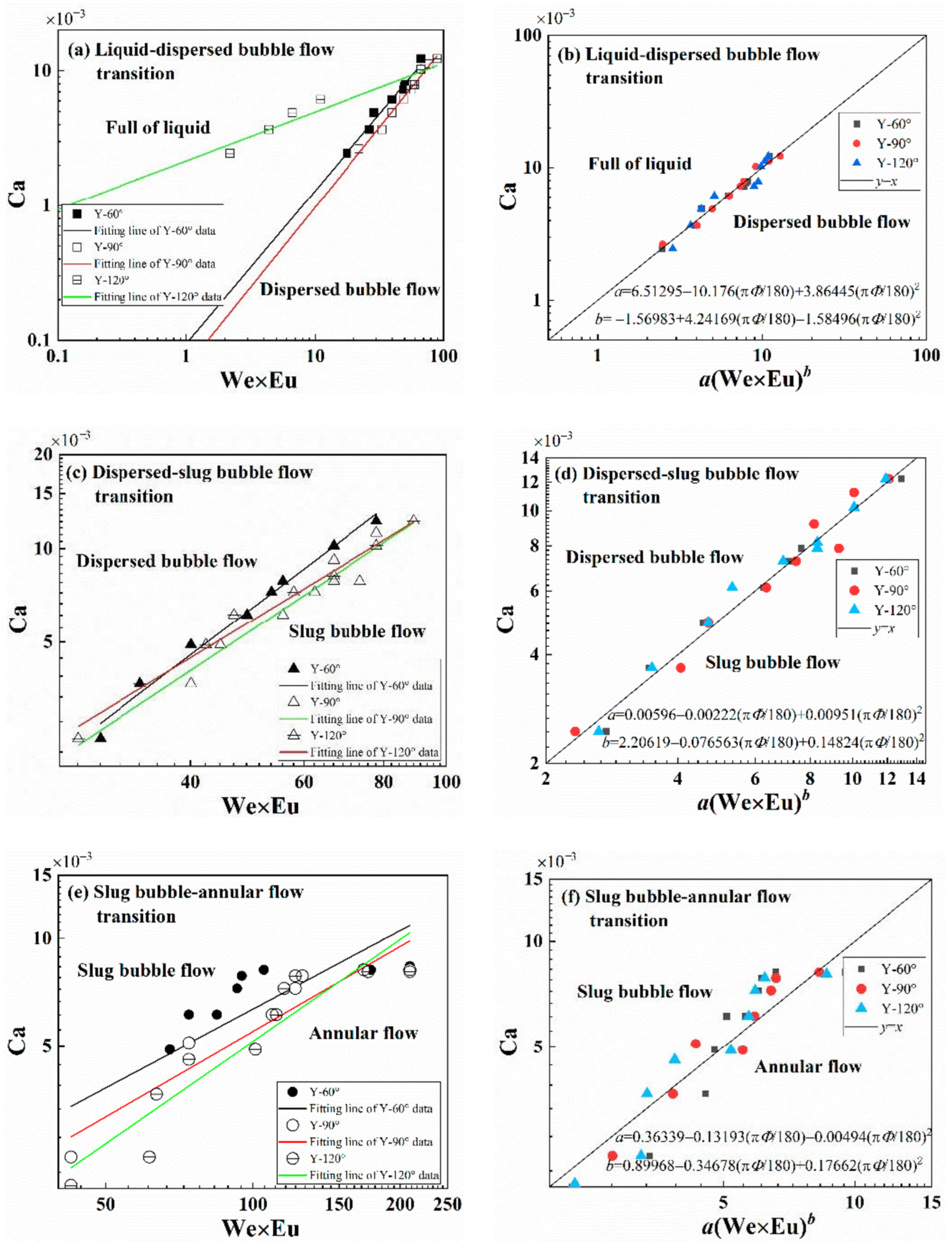
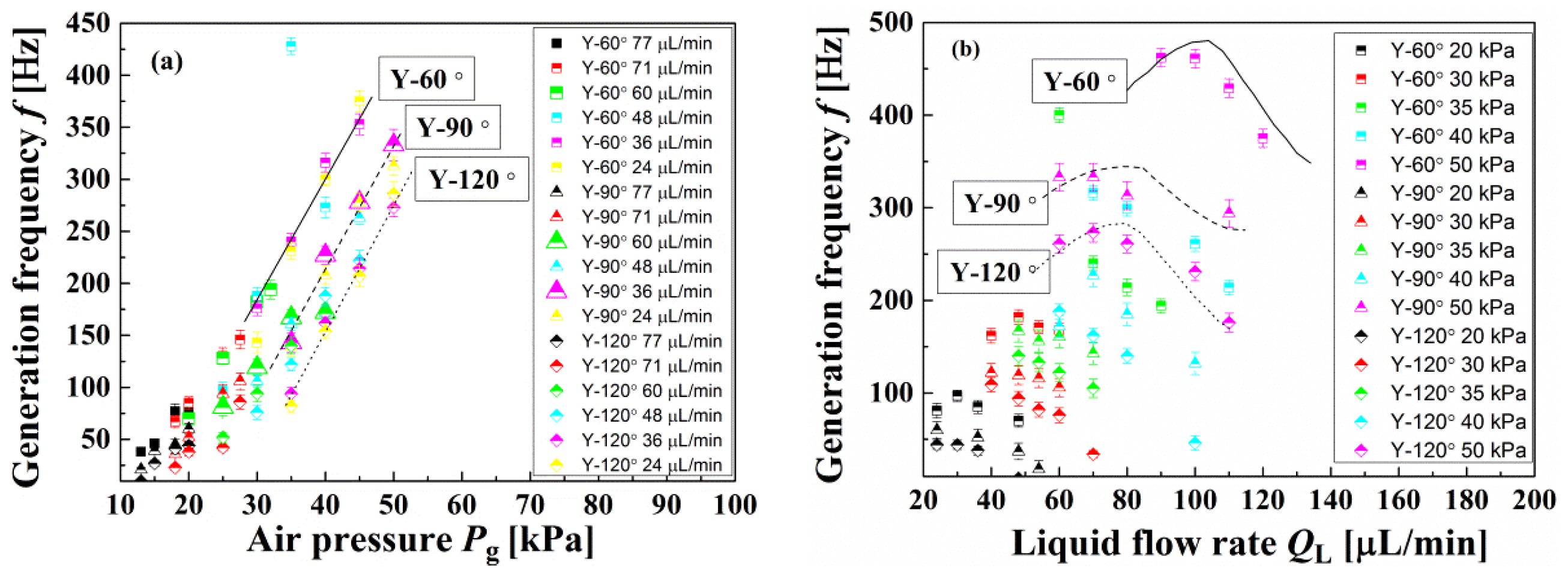
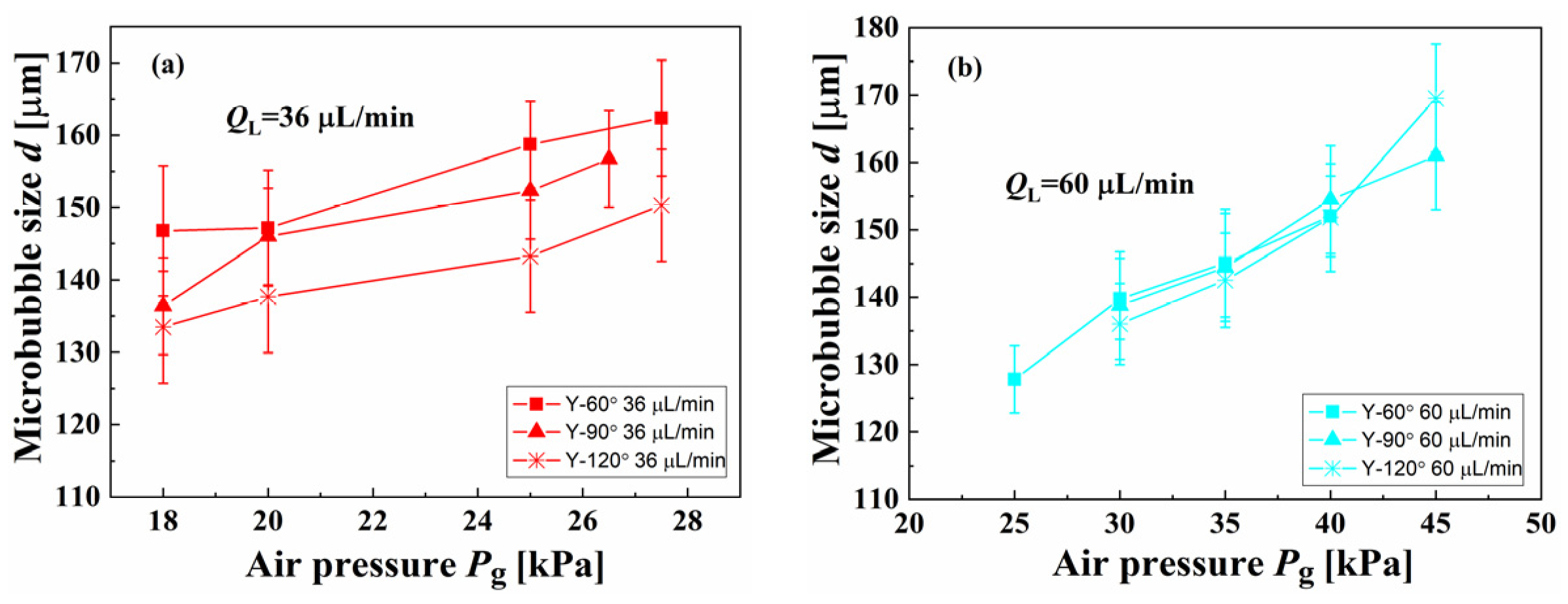
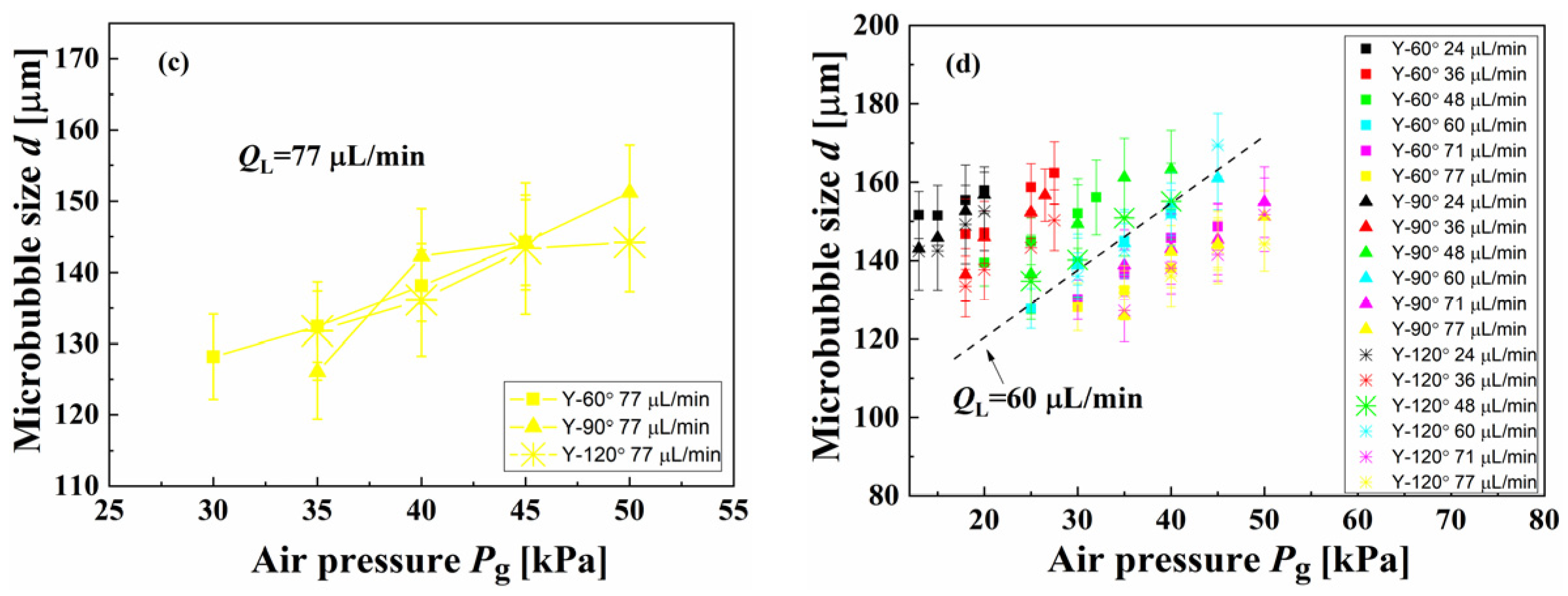
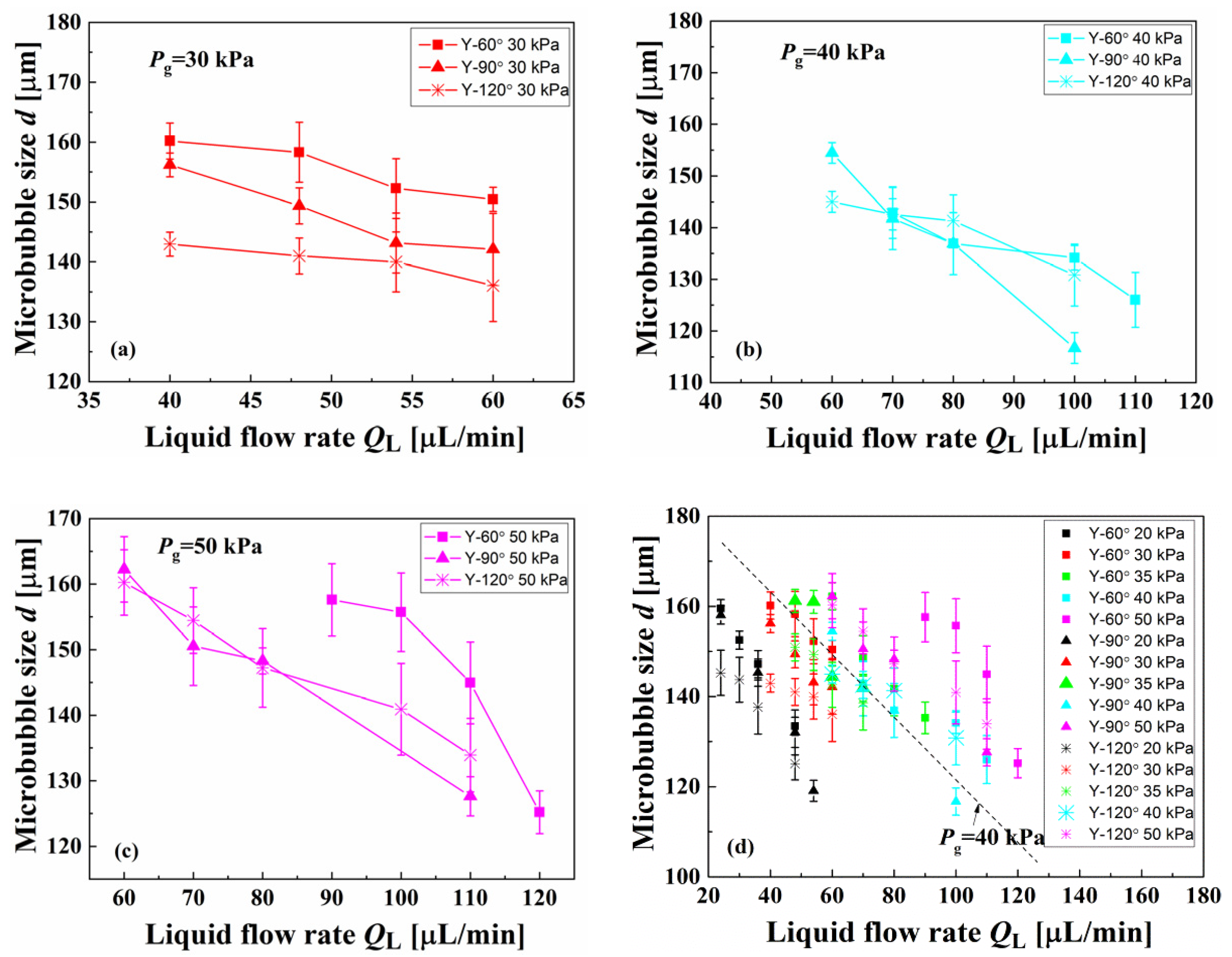

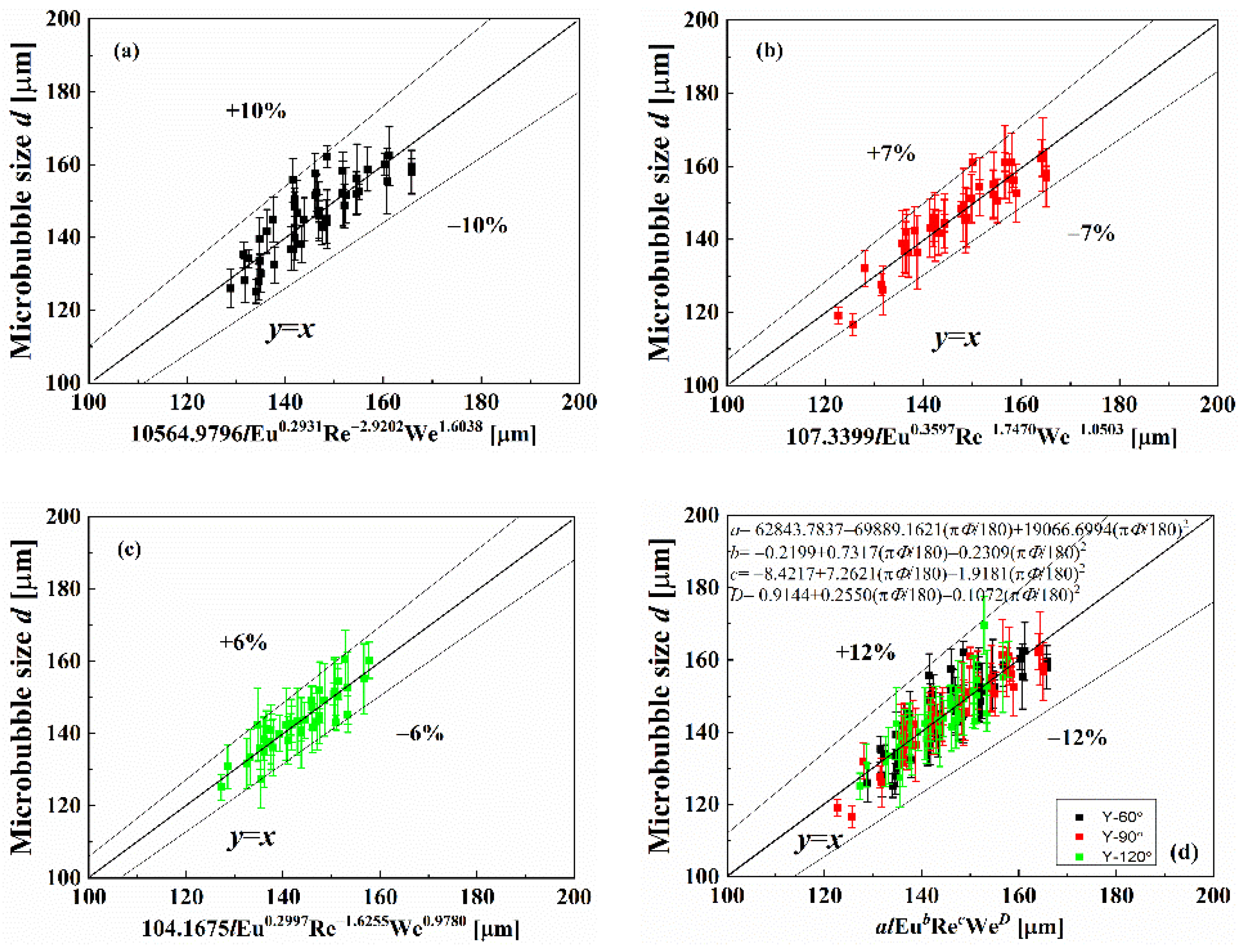
Publisher’s Note: MDPI stays neutral with regard to jurisdictional claims in published maps and institutional affiliations. |
© 2022 by the authors. Licensee MDPI, Basel, Switzerland. This article is an open access article distributed under the terms and conditions of the Creative Commons Attribution (CC BY) license (https://creativecommons.org/licenses/by/4.0/).
Share and Cite
Han, Y.; Xu, X.; Liu, F.; Wei, W.; Liu, Z. Dimensionless Analysis of the Effects of Junction Angle on the Gas-Liquid Two-Phase Flow Transition and the Scaling Law of the Microbubble Generation Characteristics in Y-Junctions. Sustainability 2022, 14, 8592. https://doi.org/10.3390/su14148592
Han Y, Xu X, Liu F, Wei W, Liu Z. Dimensionless Analysis of the Effects of Junction Angle on the Gas-Liquid Two-Phase Flow Transition and the Scaling Law of the Microbubble Generation Characteristics in Y-Junctions. Sustainability. 2022; 14(14):8592. https://doi.org/10.3390/su14148592
Chicago/Turabian StyleHan, Yu, Xiaofei Xu, Fengxia Liu, Wei Wei, and Zhijun Liu. 2022. "Dimensionless Analysis of the Effects of Junction Angle on the Gas-Liquid Two-Phase Flow Transition and the Scaling Law of the Microbubble Generation Characteristics in Y-Junctions" Sustainability 14, no. 14: 8592. https://doi.org/10.3390/su14148592
APA StyleHan, Y., Xu, X., Liu, F., Wei, W., & Liu, Z. (2022). Dimensionless Analysis of the Effects of Junction Angle on the Gas-Liquid Two-Phase Flow Transition and the Scaling Law of the Microbubble Generation Characteristics in Y-Junctions. Sustainability, 14(14), 8592. https://doi.org/10.3390/su14148592





